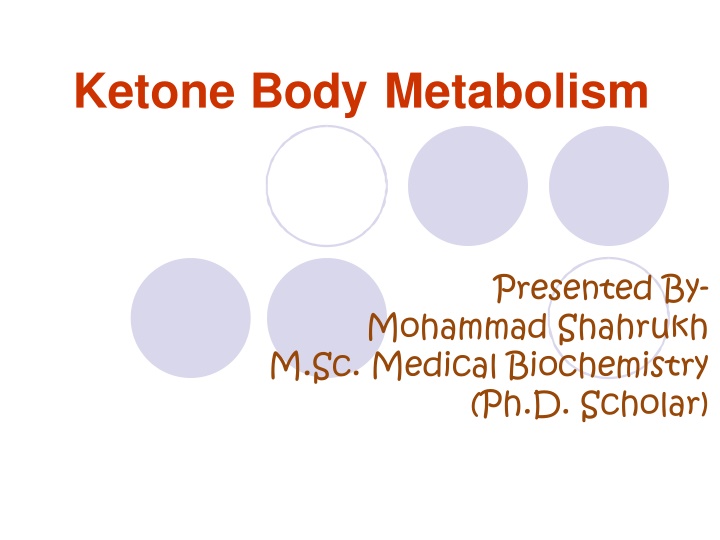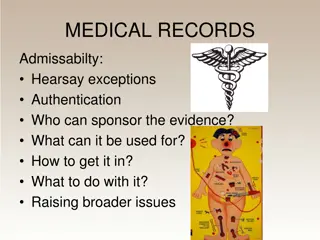
Understanding Ketone Body Metabolism: Biological Significance and Regulation
Explore the role of ketone bodies in energy production, their significance in times of low glucose availability, and the potential disorders associated with their accumulation in the body. Learn about ketogenesis, utilization of ketone bodies as fuel for the brain, heart, and muscles, and the distinction between ketosis and ketoacidosis.
Download Presentation

Please find below an Image/Link to download the presentation.
The content on the website is provided AS IS for your information and personal use only. It may not be sold, licensed, or shared on other websites without obtaining consent from the author. If you encounter any issues during the download, it is possible that the publisher has removed the file from their server.
You are allowed to download the files provided on this website for personal or commercial use, subject to the condition that they are used lawfully. All files are the property of their respective owners.
The content on the website is provided AS IS for your information and personal use only. It may not be sold, licensed, or shared on other websites without obtaining consent from the author.
E N D
Presentation Transcript
Ketone Body Metabolism Presented By- Mohammad Shahrukh M.Sc. Medical Biochemistry (Ph.D. Scholar)
OBJECTIVES Ketone bodies and their biological significance. Ketogenesis and its regulation. Utilization of ketone bodies. Disorders associated with ketone bodies.
Introduction Ketone bodies are three chemicals (Acetone, Acetoacetate and -Hydroxybutyrate) that are produced when fatty acids are broken down in excess. Production of these compounds is called ketogenesis , and this is necessary in small amounts.
Ketone bodies Acetoacetate Acetone - Hydroxybutyrate
Introduction Ketone bodies are produced from acetyl-CoA, mainly in the mitochondrial matrix of liver cells when carbohydrates are so scarce that energy must be obtained from breaking down of fatty acids.
Ketone Bodies as Fuel water soluble transported across the inner mitochondrial membrane as well as across the blood-brain barrier and cell membranes. Source of fuel for brain, heart and muscle Major energy source(75%) for brain during starvation
Introduction when excess ketone bodies accumulate, this abnormal (but not necessarily harmful) state is called ketosis. When even larger amounts of ketone bodies accumulate such that the body's pH is lowered to dangerously acidic levels, this state is called ketoacidosis.
Introduction Ketone bodies are used for energy. Ketone bodies are transported from the liver to other tissues, where acetoacetate and -hydroxybutyrate can be reconverted to acetyl-CoA to produce energy. The heart gets much of its energy from ketone bodies, although it also uses a lot of fatty acids
Introduction The brain gets its energy from ketone bodies when insufficient glucose is available (e.g. fasting). In the event of low blood glucose, most other tissues have additional energy sources besides ketone bodies (such as fatty acids) but the brain does not.
Ketone body synthesis Liver Mitochondria Some of the Acetyl-CoA produced by fatty acid oxidation in liver mitochondria is converted to Acetone, Acetoacetate and -hydroxybutyrate. Transport of fatty acids through the mitochondrial membrane is an important regulatory point.
A person on starvation will not have oxaloacetate available for the conversion of acetyl CoA to citricacid
Ketogenesis 1. First step Reverse of Thiolase. 2. Second step Synthesis of HMG CoA. These reactions are mitochondrial analogues of the (cytosolic) first two steps of cholesterol synthesis. 3. Third step HMG CoALyase.
Ketogenesis Reverse of Thiolasestep 2 AcetylCoA Thiolase CoA-SH Acetoacetyl CoA
Ketogenesis Synthesis of HMG CoA Acetoacetyl CoA Acetyl CoA HMG CoAsynthase CoA-SH
Ketogenesis Lysis of HMG CoA -Hydroxy- -Methyl Glutaryl CoA (HMG CoA) HMG CoALyase CoA-SH Acetoacetate
Ketogenesis Parent ketone body producing other ketone bodies Acetoacetate Non-enzymatic decarboxylation NADH+H+ -Hydroxy butyrate dehydrogenase NAD+ CO2 -Hydroxy butyrate Acetone
Acetone Acetone is formed from spontaneous decarboxylation of acetoacetate. In a corresponding manner, the levels of acetone are much lower than those of the other two types of ketone bodies. Acetone is produced in small quantities; highly volatile. Hence it is not used by the body.
Acetone (Contd) Acetone cannot be converted back to acetyl-CoA, so it is excreted in the urine and exhaled (it can be exhaled because it has a high vapor pressure and thus evaporates easily). The exhalation of acetone is responsible for the characteristic "fruity" odour of the breath of persons in ketotic states.
Liver cannot utilizes ketone bodies -hydroxy butyrate is converted to acetoacetate for energy. For oxidation of Acetoacetate, it has to be activated to Acetoacetyl CoA by succinyl CoA-acetoacetate CoAtransferase . This transferase is absent in liver.
Ketone Bodies As energy sources -Hydroxybutyrate Acetoacetate Succinyl CoA Succinyl CoA-acetoacetate CoAtransferase Thiolase Succinic acid Acetoacetyl CoA 2 Acetyl CoA TCACycle
FFA Acyl CoA -oxidation Acetyl CoA Acetyl CoA Thiolase Acetoacetyl CoA Succinate TCA OAA HMG CoA TCA cycle cycle CoA transferase Succinyl CoA Citrate Acetoacetate Acetoacetate NADH+H+ NAD+ NADH+H+ NAD+ -OH butyrate -OH butyrate
Liver Blood Extrahepatic Tissues Acyl CoA FFA Glucose Glucose Acyl CoA Urine Acetyl CoA Acetyl CoA Ketone bodies Ketone bodies Ketone bodies TCA Cycle TCA Cycle Acetone Lungs 2CO2 2CO2
Triacylglycerol 1 Adipose tissue FFA Blood FFA Liver Acyl CoA CPTI gateway Esterification 2 -oxidation Acylglycerols Acetyl CoA Citric acid cycle Ketogenesis 3 Ketone bodies CO2
Regulation of ketogenesis in adipose tissue : The factors regulating mobilization of FFAs from adipose tissue are important in controlling ketogenesis. The liver, both in fed and in fatsing conditions, extracts about 30% of the FFAs passing through it. At high concentrations of FFA, the flux passing through the liver is substantial.
Carnitine Palmitoyltransferase-I (CPT-I) Gateway CPT-I activity regulates the entry of long chain acyl groups into mitochondria. The activity of CPT-I is Low in the fed state depression of FA oxidation. High in starvation FA oxidation Increase.
Carnitine Palmitoyltransferase-I (CPT-I) Gateway Malonyl CoAis formed by acetyl CoA carboxylase in the fed state potent inhibitor of CPT I . In fed state, FFAs enter the liver cells in low conc. And are nearly all esterified to Acylglycerols and transported out of the liver in VLDL. sed [ Insulin ] / [ Glucagon ] ratio in starvation inhibit ketogenesis.
Carnitine Palmitoyltransferase-I (CPT-I) Gateway With the onset of starvation, conc of FFA increase, acetyl CoA carboxylase is inhibited by acyl CoA, and [ malonyl CoA ] decreases. This decrease of [ malonyl CoA ] releases the inhibition on CPT-I, allowing more acyl CoA to be -oxidized.
Partition of Acetyl CoA between the pathway of ketogenesis and oxidation to CO2 This partition is so regulated that the total free energy captured in ATP which results from the oxidation of FFAs remains constant. Ketogenesis allows liver to oxidize increasing quantities of FAs within a tightly coupled system of oxidative phosphorylation, without increaing its total energy expenditure.
Partition of Acetyl CoA between oxidation and KBproduction Complete oxidation of palmitate: 129ATP If acetoacetate is the end product : 7 cycles of betaoxidation of palmitate forms 8 acetyl CoA,which join to form 4 acetoacetate. 5 ATP for each cycle of betaoxidation. Total ATP formed35. 2 are used for initialactivation. Thus 33 ATP are formed if acetoacetate is the end product. If -OH butyrate is the end product: 4 acetoacetate form 4 -OH butyrate using 4 NADH(i.e.,12ATP) Thus 33-12= 21ATP
KB in blood & urine Normal KB in plasma: 0.2mmol/L Starvation : 3-5 mmol/L Diabetic ketoacidosis: >12mmol/L KB of >12mmol/L, saturates all oxidative pathways. Normal KB in urine: <1mg/day
Metabolic Acidosis due to KBs Both acetoacetate and beta-hydroxybutyrate are acidic, and, if levels of these ketone bodies are too high, the pH of the blood drops, resulting in ketoacidosis. This happens in untreated Type I diabetes, and also during prolonged starvation.
Excess of Ketogenesis (Cause) Diabetes Mellitus (Untreated) Extreme starvation Gluconeogenesis (Liver) Oxaloacetate (TCA cycle intermediate) is used Consumption of Acetyl CoA is sloweddown Excess of Acetyl CoA inLiver
Excess of Ketogenesis (Cause) contd. Liver catabolizes fatty acids to meet the energy demand by other tissues Excess of Acetyl CoA is produced,which are destined to form ketone bodies. Ketone bodies are transported by blood to Muscle and Brain. Ketone body formation regenerates free CoA, which is required for -oxidation.
Metabolic Acidosis due to KBs CH3COCH2CO2H pKa =3.6 AcetoaceticAcid OH CH3CHCH2CO2H pKa =4.7 -Hydroxybutyrate Concentration of acetoacetic acid can result in metabolic acidosis (pH 7.1) affinity of Hb for O2.
Metabolic Acidosis due to KBs Ketone bodies being acidic in nature, release H+ ions into blood. They are buffered by HCO3 . H++ HCO3 H2CO3 H2O+CO2 - CA CA Exhaled Continuous production of ketone bodies depletes alkali reserve resulting in ketoacidosis.
Ketone bodies in Starvation After the diet has been changed to lower blood glucose for 3 days, the brain gets 30% of its energy from ketone bodies. After 40 days, this goes up to 70% (during the initial stages the brain does not burn ketones, since they are an important substrate for lipid synthesis in the brain). The brain retains some need for glucose, because ketone bodies can be broken down for energy only in the mitochondria, and brain cells' long thin axons are too far from mitochondria.
Starvation ketoacidosis Absence of intake of food No stimuli from intestine to release insulin from pancreas. Insulin & glucagon Lipolysis & Oxidation of fatty acids Ketoacidosis
Laboratory diagnosis of KA due to starvation. Blood glucose: low, may be < 50 mg/dl Serum bicarbonate:< 15 mEq/L pH: <7.3 Urine glucose: Nil Ketonuria: 3+
Diabetic ketoacidosis(DKA) DKA is due to a marked deficiency of insulin in the face of hormones that oppose the effects of insulin, particularly glucagon. Even small amounts of insulin can turn off ketoacid formation. Hormones that antagonise insulin action: Glucagon Cortisol Oestrogens Growth hormone Catecholamines
Ketone Bodies andDiabetes "Starvation of cells in the midst of plenty" Glucose is abundant in blood, but uptake by cells in muscle, liver, and adipose cells is low due to absence of insulin. Cells, metabolically starved, turn to gluconeogenesis and fat/protein catabolism In type I diabetics, OAA is low, due to excess gluconeogenesis, so Acetyl CoA from fat/protein catabolism does not go to TCA, but rather to ketone body production Acetone can be detected on breath of type I diabetics
Ketones in Diabetes Mellitus Ketogenic AminoAcids Fatty Acids Glycolysis Glucose Oxaloacetate Acetyl CoA Gluconeogenesis Ketone Bodies TCA Cycle Glucogenic AminoAcids Citrate Glucose in cells Gluconeogenesis Oxaloacetate Fatty Acidbreakdown Acetoacetyl CoA Ketone Bodies
Laboratory diagnosis of DKA Blood glucose:> 250 mg/dl Serum bicarbonate:< 15 mEq/L pH: <7.3 Urine glucose: +++ Ketonuria: 3+




